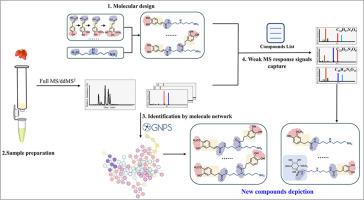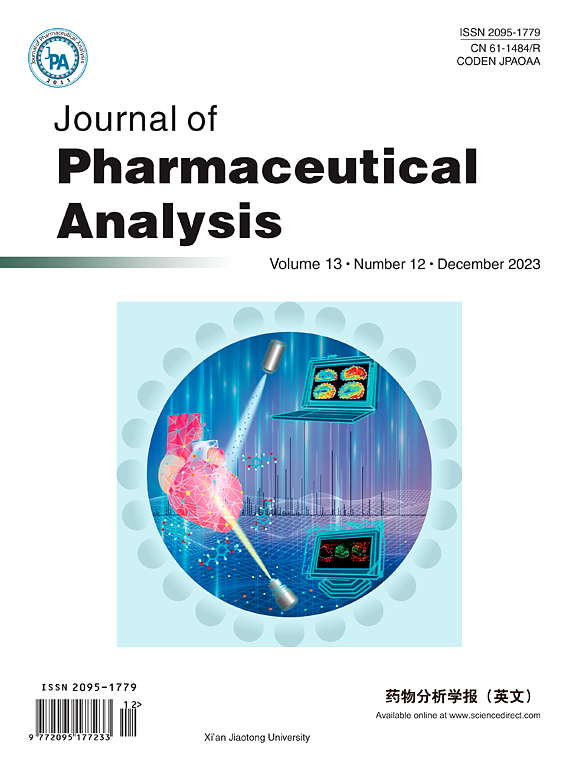The “depict” strategy for discovering new compounds in complex matrices: Lycibarbarspermidines as a case
IF 8.9
1区 医学
Q1 PHARMACOLOGY & PHARMACY
引用次数: 0
Abstract
The comprehensive detection and identification of active ingredients in complex matrices is a crucial challenge. Liquid chromatography coupled with high-resolution mass spectrometry (LC-HRMS) is the most prominent analytical platform for the exploration of novel active compounds from complex matrices. However, the LC-HRMS-based analysis workflow suffers from several bottleneck issues, such as trace content of target compounds, limited acquisition for fragment information, and uncertainty in interpreting relevant MS2 spectra. Lycibarbarspermidines are vital antioxidant active ingredients in Lycii Fructus, while the reported structures are merely focused on dicaffeoylspermidines due to their low content. To comprehensively detect the new structures of lycibarbarspermidine derivatives, a “depict” strategy was developed in this study. First, potential new lycibarbarspermidine derivatives were designed according to the biosynthetic pathway, and a comprehensive database was established, which enlarged the coverage of lycibarbarspermidine derivatives. Second, the polarity-oriented sample preparation of potential new compounds increased the concentration of the target compounds. Third, the construction of the molecular network based on the fragmentation pathway of lycibarbarspermidine derivatives broadened the comprehensiveness of identification. Finally, the weak response signals were captured by data-dependent scanning (DDA) followed by parallel reaction monitoring (PRM), and the efficiency of acquiring MS2 fragment ions of target compounds was significantly improved. Based on the integrated strategy above, 210 lycibarbarspermidine derivatives were detected and identified from Lycii Fructus, and in particular, 170 potential new compounds were structurally characterized. The integrated strategy improved the sensitivity of detection and the coverage of low-response components, and it is expected to be a promising pipeline for discovering new compounds.

在复杂基质中发现新化合物的“描述”策略:以枸杞亚精胺为例
复杂基质中有效成分的综合检测和鉴定是一个重要的挑战。液相色谱-高分辨率质谱联用(LC-HRMS)是从复杂基质中探索新型活性化合物的最重要的分析平台。然而,基于lc - hrms的分析工作流程存在几个瓶颈问题,例如目标化合物的痕量含量,片段信息的获取有限,以及解释相关MS2光谱的不确定性。枸杞子亚精胺是枸杞子中重要的抗氧化活性成分,但由于其含量低,报道的结构仅集中在二咖啡因亚精胺上。为了全面检测枸杞亚精胺衍生物的新结构,本研究开发了一种“描述”策略。首先,根据生物合成途径设计了潜在的新型枸杞亚精胺衍生物,并建立了完整的数据库,扩大了枸杞亚精胺衍生物的覆盖范围。其次,极性取向样品制备的潜在新化合物增加了目标化合物的浓度。第三,基于枸杞亚精胺衍生物裂解途径的分子网络构建,拓宽了鉴定的全面性。最后,通过数据依赖扫描(DDA)和平行反应监测(PRM)捕获弱响应信号,显著提高了目标化合物MS2片段离子的获取效率。基于上述综合策略,共从枸杞子中检测鉴定出210个枸杞子亚精胺类化合物,其中170个具有结构表征的潜在新化合物。该综合策略提高了检测的灵敏度和低响应组分的覆盖率,有望成为发现新化合物的有前途的管道。
本文章由计算机程序翻译,如有差异,请以英文原文为准。
求助全文
约1分钟内获得全文
求助全文
来源期刊

Journal of Pharmaceutical Analysis
Chemistry-Electrochemistry
CiteScore
16.20
自引率
2.30%
发文量
674
审稿时长
22 weeks
期刊介绍:
The Journal of Pharmaceutical Analysis (JPA), established in 2011, serves as the official publication of Xi'an Jiaotong University.
JPA is a monthly, peer-reviewed, open-access journal dedicated to disseminating noteworthy original research articles, review papers, short communications, news, research highlights, and editorials in the realm of Pharmacy Analysis. Encompassing a wide spectrum of topics, including Pharmaceutical Analysis, Analytical Techniques and Methods, Pharmacology, Metabolism, Drug Delivery, Cellular Imaging & Analysis, Natural Products, and Biosensing, JPA provides a comprehensive platform for scholarly discourse and innovation in the field.
 求助内容:
求助内容: 应助结果提醒方式:
应助结果提醒方式:


